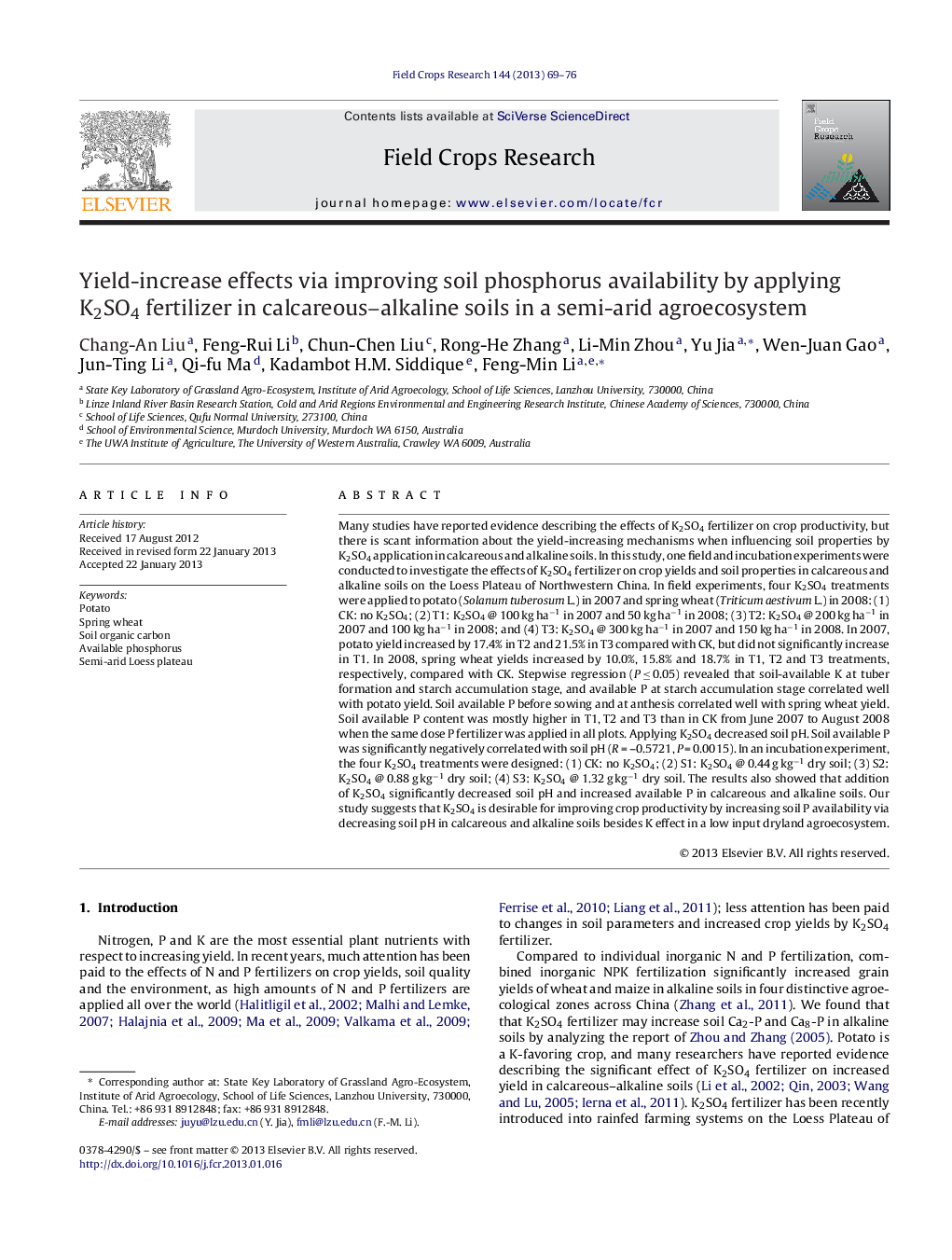| کد مقاله | کد نشریه | سال انتشار | مقاله انگلیسی | نسخه تمام متن |
|---|---|---|---|---|
| 4510227 | 1624719 | 2013 | 8 صفحه PDF | دانلود رایگان |

Many studies have reported evidence describing the effects of K2SO4 fertilizer on crop productivity, but there is scant information about the yield-increasing mechanisms when influencing soil properties by K2SO4 application in calcareous and alkaline soils. In this study, one field and incubation experiments were conducted to investigate the effects of K2SO4 fertilizer on crop yields and soil properties in calcareous and alkaline soils on the Loess Plateau of Northwestern China. In field experiments, four K2SO4 treatments were applied to potato (Solanum tuberosum L.) in 2007 and spring wheat (Triticum aestivum L.) in 2008: (1) CK: no K2SO4; (2) T1: K2SO4 @ 100 kg ha−1 in 2007 and 50 kg ha−1 in 2008; (3) T2: K2SO4 @ 200 kg ha−1 in 2007 and 100 kg ha−1 in 2008; and (4) T3: K2SO4 @ 300 kg ha−1 in 2007 and 150 kg ha−1 in 2008. In 2007, potato yield increased by 17.4% in T2 and 21.5% in T3 compared with CK, but did not significantly increase in T1. In 2008, spring wheat yields increased by 10.0%, 15.8% and 18.7% in T1, T2 and T3 treatments, respectively, compared with CK. Stepwise regression (P ≤ 0.05) revealed that soil-available K at tuber formation and starch accumulation stage, and available P at starch accumulation stage correlated well with potato yield. Soil available P before sowing and at anthesis correlated well with spring wheat yield. Soil available P content was mostly higher in T1, T2 and T3 than in CK from June 2007 to August 2008 when the same dose P fertilizer was applied in all plots. Applying K2SO4 decreased soil pH. Soil available P was significantly negatively correlated with soil pH (R = –0.5721, P = 0.0015). In an incubation experiment, the four K2SO4 treatments were designed: (1) CK: no K2SO4; (2) S1: K2SO4 @ 0.44 g kg−1 dry soil; (3) S2: K2SO4 @ 0.88 g kg−1 dry soil; (4) S3: K2SO4 @ 1.32 g kg−1 dry soil. The results also showed that addition of K2SO4 significantly decreased soil pH and increased available P in calcareous and alkaline soils. Our study suggests that K2SO4 is desirable for improving crop productivity by increasing soil P availability via decreasing soil pH in calcareous and alkaline soils besides K effect in a low input dryland agroecosystem.
► K2SO4 improved crop yields in calcareous-alkaline soils.
► K2SO4 increased soil AP content when the same dose of P fertilizer was applied.
► Soil AP was significantly negatively correlated with soil pH.
► Soil AP content was crucial for improving crop yields in calcareous-alkaline soils.
Journal: Field Crops Research - Volume 144, 20 March 2013, Pages 69–76